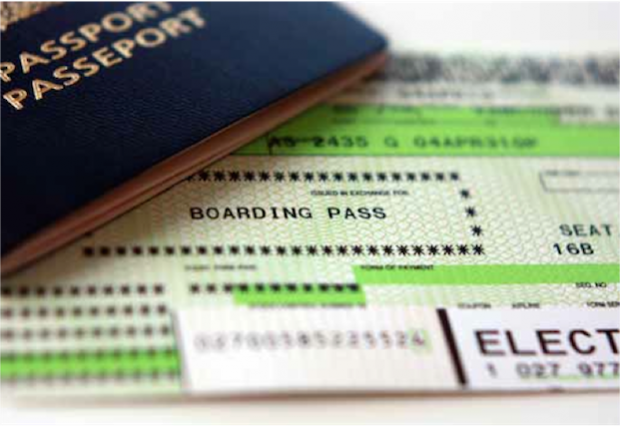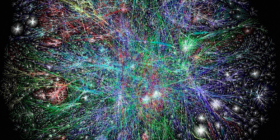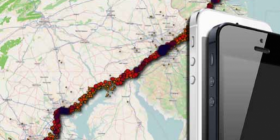Our comprehensive report on surveillance in Canada is available. Download it here.
Trend 6 – The Global Surveillance Market

The term global surveillance evokes international espionage and the spreading tentacles of clandestine intelligence agencies—the stuff of spy thrillers and, more soberly, organizations such as the US National Security Agency (NSA). Such global monitoring exists, of course, but much more mundanely, global surveillance may now also refer to international standards for airport security or simply to tagged consumer goods with standardized codes. Your razor blades or your blouse may contain an RFID tag conforming to a universal electronic product code and associated with global data synchronization. These grand technical terms matter little, but what they point to is a world in which data connections allow the blades or the blouse to be traced back to their producers or forward to the person currently using them.
Processes that used to be separated by national borders are increasingly connected beyond those borders. The globalization of surveillance, then, refers to how information once held in national silos is now more typically digital and thus flows more easily across borders. One may use a credit card, for example, to make purchases in another country, and personal details accompany such transactions. We have also become more aware of these connections, these data flows. We expect similar security regimes in airports everywhere, and we are aware that our passports are machine-readable around the world. Those scanners recognize our identification details even though the country we are in may be geographically and culturally remote from our own.
Surveillance in Canada is deeply affected by broad global trends. American politics and policies are one obvious source of influence, but the global surveillance connections extend much more broadly. These global influences may involve subtle efforts to shape policy directions, the sharing of expertise, or compliance with international standards and regulations. For example, in 2007, Canada signed a “partnership” agreement with Israel to cooperate on public safety.1 Given that Public Safety Canada works cooperatively with the Canada Border Services Agency (CBSA), the Royal Canadian Mounted Police (RCMP), the Canadian Security Intelligence Service (CSIS), and Correctional Services of Canada (CSC), surveillance practices have to be central to this international arrangement. Israeli security uses ethnic- profiling practices—so does this mean that Canada will also extend such discriminatory techniques to its border?2 Whatever the specifics, to appreciate both the contemporary and future dynamics of surveillance in Canada, one must think about Canada in the context of globalization.
Surveillance has been greatly affected by globalization. People are as likely to be observed by video surveillance cameras whether they are in Toronto, Johannesburg, or Tokyo. National identity card systems can be found in the Netherlands, India, and Brazil. But it is not simply that similar technologies are used or that the same technology companies operate in different countries: surveillance processes and procedures are becoming more alike. No matter which country you travel to, at the national border, you are likely to be asked similar questions and subjected to similar kinds of observations. Frequently, international processes—the use of automated teller machines (ATMs), for example—connect to networks that share information globally.
The globalization of surveillance is not a finished process; it is ongoing. This does not mean that the same surveillance practices occur everywhere, even though many may be widespread. Although surveillance cameras are used in different cities around the globe, for instance, they are not necessarily conducting the same form of surveillance. Systems can differ in terms of both the groups of people being watched and the underlying reasons for their monitoring. Indeed, such systems may not involve a human watcher at all: video camera footage is now often simply recorded without observation and is increasingly monitored by automated software systems.
Despite the frequent similarities in surveillance around the world, the networks that connect surveillance systems are not necessarily global; they may involve local networks created for local purposes. In London, England, the city with the highest density of video surveillance cameras in the world, two cameras located very close to one another may be part of entirely different systems operated by different local authorities or police forces. If you tried to connect them, you would discover that they are incompatible. Some are still analogue, recording to VHS tape; some are digital and cable-connected; some transmit information wirelessly. Likewise, some are watched by dedicated operators in control rooms connected to the police, while others are sporadically monitored; some merely record, and some are “dummy” systems that merely resemble surveillance cameras. There is no seamless transfer of video surveillance images around London, let alone around the world, despite the ambition of security professionals to move in that direction.
These differences are compatible with globalization because globalization does not mean homogeneity. Thinking about the globalization of surveillance involves recognizing both similarities and differences in surveillance around the world. National borders and national cultures still matter. Canada is just one kind of national surveillance society. China, for instance, practices a form of totalitarian surveillance that is still functionally compatible with capitalist economic development. Intensive surveillance of political and cultural views and opinions in China can result in significant impacts on individual dignity, life chances, and freedom. There are also significant differences among Western states. Some European states, such as Germany, have constitutional rights that make it more difficult to adopt technology-dominated surveillance. Sweden, in contrast, treats much of the personal information gathered by the state, such as the data in an individual tax return, as public property and makes it publicly accessible. In the rapidly developing economies of Brazil and Mexico, it is normal for wealthier citizens to eschew the limited protections offered by the state and opt for private security and surveillance providers, and for the poor to be left unwatched and undefended unless they turn to one of the many gangs that are the source of the more privileged citizens’ fears.
Globalization Processes
There are many processes of globalization, or, to be more precise, different processes, practices, policies, and technologies are being globalized in different ways and at different speeds. Forms of globalization that are related to surveillance are discussed here under four interconnected themes: globalizing regional interests, globalizing governance, globalizing standards, and globalizing technologies.
Globalizing Regional Interests
In many regards, the United States dominates global communications. The Internet—a US military Cold War innovation that was originally intended as a form of self-repairing communication in the event that total war destroyed conventional forms of communication (the Internet reroutes around damage)—remains largely under US-based administration. A key example is ICANN (the Internet Corporation for Assigned Names and Numbers), the organization that decides how Internet domain names and addresses are assigned to countries and other bodies. The Internet, like other communication systems, has produced new freedoms and ways of sharing and organizing between people. Its protocols, however, depend upon automatically sorting and categorizing vast amounts of data. Although one might think that it would be impossible to manage all of these surveillance data, the problem of volume is proving to be a technical one. US intelligence—in particular, the National Security Agency (NSA), through its echelon and prism systems— can use back doors in communications hardware and software to tap into, siphon, and sift much global communications traffic, including the Internet, email, telephone, fax, and telex.* Although other nation-states monitor and control the Internet and, like China or Iran, may do so with greater effect within their national borders, those countries do not have the global reach of the United States. This is, in part, because the United States has enlisted allies into its surveillance practices.
Globalizing Governance
Many forms of surveillance operate at global levels as part of global institutions—like the World Health Organization, the World Bank, and the International Monetary Fund (IMF)—that exist largely to monitor global information flows in a variety of domains, from the economic to the environmental. Some of these surveillance systems, particularly those concerned with environmental change or the monitoring of human or agricultural diseases, provide desirable public benefits. In other areas, this is more debatable. A large proportion of contemporary surveillance at the global level exists to protect commercial interests, or to advance the globalization of capitalism itself.
Agencies that operate at a global level, such as the IMF, have a clear surveillance function, and their activities alter the destiny of millions, as, for example, when a national economy requires “structural adjustment” to meet IMF criteria for economic stability. This is similar to how banks and other financial institutions use information that they acquire through surveillance (including clients’ personal and financial data from both the bank itself and external credit-rating agencies, as well as “softer” information acquired via interviews and meetings) to make decisions about the services that they offer individuals. The combination of data from different sources results in profiles that determine the suitability of applicants for loans and other services. Nation-states are subjected to comparable kinds of dataveillance and profiling: public and private information companies collect and collate data and perform both human and, more commonly, algorithmic (software-based) judgments on data relating to nation-states and then profile these countries to assess their credit-worthiness and relative place in global markets. As with the consumer-banking and credit-rating systems, much of this global economic surveillance infrastructure is corporate and not run by nation-states or democratic international organizations: the credit-ratings agencies that define the credit-worthiness of nations—including Standard & Poor’s, Moody’s, and Fitch Ratings—are private companies accountable to no one but their shareholders.
Globalizing Standards
The third form of globalization that is important to surveillance is standardization. Increasingly, global expert and technical forums—such as the Frame Relay Forum, which determines the physical characteristics of telephone and other communication hardware connections, or intergovernmental gatherings such as the G20 summits or OECD meetings—set global standards relating to security and surveillance. In the past, such standards might have related solely to technologies. These standards are significant in their own right since they influence the ease or difficulty with which states can monitor communications systems. However, with the creation of the International Organization for Standardization’s (ISO’s) Societal Security standard, which includes technical standards for everything from emergency evacuation procedures to video cameras for security purposes, standards now relate increasingly to practices, including security and surveillance practices.3 Much of this standardization combines state and corporate interests. Most technologically advanced states have (or have proposed) laws that require Internet service providers (ISPs) to hand over personal traffic and/or content data to the police, and to block those who contravene copyright and licensing regulations from accessing the Internet. In large part, state surveillance supports state security and competition between corporations and does not necessarily take into account the interests of individuals or groups.
Globalizing Technologies
Finally, many aspects of the globalization of surveillance occur through more elusive and opaque processes. For example, video surveillance has spread globally largely through policy transfer between nation-states and, more importantly, “lesson learning” among the private sector (including both producers of technologies and private-security operators), police forces, and local governments, those dubbed by some as “travelling technocrats.”4 In turn, policy transfer relies on fact-finding, conferences, courses, and the sharing of best practices in professional publications. Many of the visible material forms of surveillance that one sees more and more often, especially within the globally connected “World Cities”—including Toronto, Montréal, Calgary, and Vancouver—are the result of such semi-formal processes of global knowledge-sharing, marketing, and policy learning.
Conclusion
Surveillance trends in Canada must be understood not merely in a national but in a global context of laws, standards, practices, technologies, and organizations. Globalization helps to accelerate the development of surveillance in all areas, particularly over the new global economy. Such surveillance touches ordinary consumers and travellers in their everyday transactions as well as in security-related fields. New global, international, or bilateral agreements frequently spell a formal commitment to new surveillance measures; examples of such agreements include no-fly lists, application programming interface (API) data, and border agreements with the United States. Globalization also results in an increasingly competitive and innovative marketplace for all surveillance technologies, from the most expensive military platforms to the cheapest private devices, including, for example, drones. Many of these technologies are also increasingly hybrid and are marketed with only minor variations for military and civilian uses. The spread of global norms, whether in the form of the ISO’s Societal Security standard or through more informal understandings of best practices that do not distinguish between different contexts and histories, can allow special security interests to appear neutral and can help to foreclose debate in the name of applying what is already apparently globally acceptable. Read the full trend in the free download of the Transparent Lives: Surveillance in Canada book.
- 1. Rebecca Anna Stoil, “Israel, Canada Sign Security Accord,” Jerusalem Post, 29 November 2007, http://www.jpost.com/Israel/Israel-Canada-sign-security-accord.
- 2. See Andrew Stevens, “Surveillance Policies, Practices and Technologies in Israel and the Occupied Palestinian Territories: Assessing the Security State,” The New Transparency: Surveillance and Social Sorting, Working Paper 4, November 2011, http://www.sscqueens.org/ sites/default/files/2011-11-Stevens-WPIV_0.pdf.
- 3. International Organization for Standardization, Societal Security: Guideline for Incident Preparedness and Operational Continuity Management, ISO/PAS 22399:2007, http://www.iso.org/iso/ home/store/catalogue_tc/catalogue_detail.htm?csnumber=50295.
- 4. Wendy Larner and Nina Laurie, “Travelling Technocrats, Embodied Knowledges: Globalising Privatisation in Telecoms and Water,” Geoforum 41, no. 2 (2010): 218–26.














